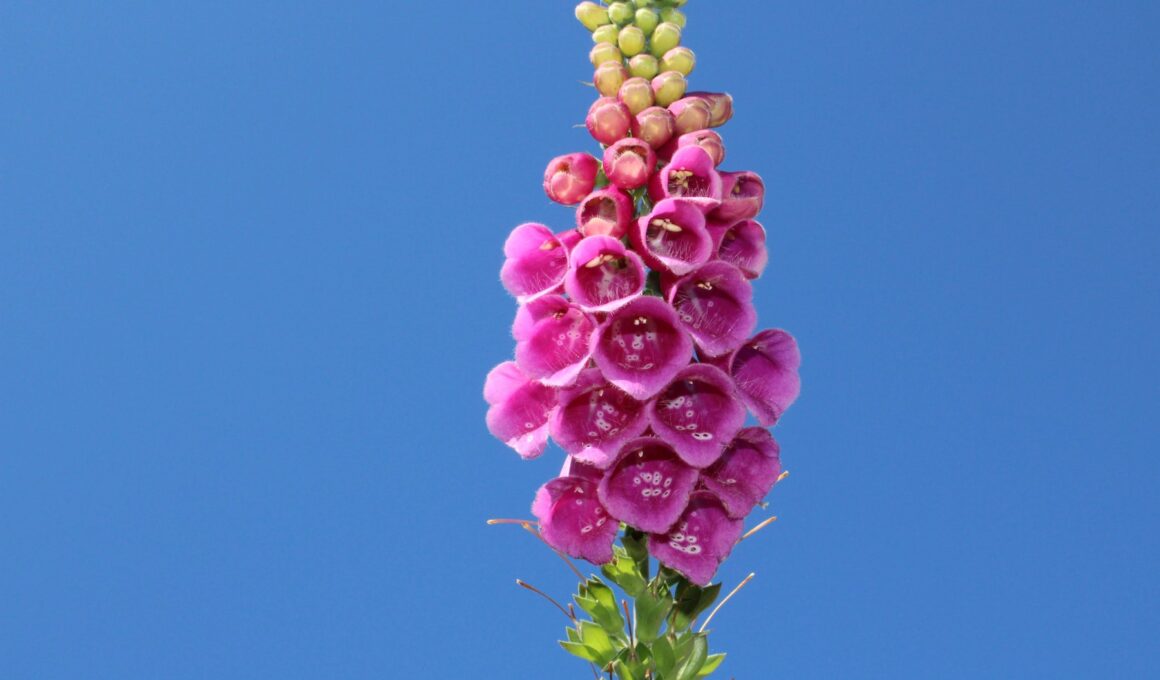Do you have foxglove growing in your garden? While this plant may bring beauty to your outdoor space with its tall spires of colorful blooms, it’s important to understand the potential risks associated with it. As a conscientious gardener, you want to ensure the safety of your family, pets, and any visitors to your garden.
So, should you remove foxglove from your garden? Let’s take a closer look at the benefits and risks of this plant to help you make an informed decision.
First, it’s important to understand that foxglove contains a potent cardiac glycoside called digoxin. This compound can have both therapeutic and toxic effects on the body, depending on the dosage. While digoxin is used in modern medicine to treat certain heart conditions, ingesting even a small amount of foxglove can cause serious health problems in humans and animals. This is why some gardeners choose to remove foxglove from their outdoor spaces altogether.
But before you make a decision, let’s explore the benefits of foxglove and alternative options available to you.
Understanding the Risks Associated with Foxglove
You’ll want to be aware of the potential dangers that come with growing these beautiful flowers. Foxglove plants are incredibly toxic, and can cause serious harm if ingested. In fact, foxglove toxicity can be fatal if not treated promptly.
Despite its poisonous nature, foxglove has historically been used in medicine for its cardiac glycosides, which can help regulate heart rhythm. However, these compounds are potent and can easily cause harm if not used properly. It’s important to note that medical professionals have the expertise and knowledge to use foxglove safely, and shouldn’t be used by individuals without proper training.
If you’re considering removing foxglove from your garden, it’s important to weigh the potential risks and benefits. While foxglove can be dangerous if not handled properly, it also has a rich history of medical uses and can be a beautiful addition to any garden. Ultimately, the decision is up to you, but it’s important to be informed about the potential risks before making a choice.
Benefits of Foxglove
If you’re looking for a beautiful and medicinal addition to your flora, foxglove may be the perfect plant for you. Not only does it add a pop of color to your garden, but it also has various medicinal properties that can benefit your health.
Here are some benefits of foxglove:
- Heart medication: Foxglove contains the chemical compound digitalis, which is used to treat heart conditions such as heart failure and atrial fibrillation.
- Pain relief: The leaves of the foxglove plant can be made into a tea or poultice to relieve pain, such as headaches and muscle aches.
- Pollinator attraction: Foxglove’s bell-shaped flowers are a favorite among bees and hummingbirds, making it a great addition to any pollinator garden.
Incorporating foxglove into your garden can not only add beauty, but it can also provide medicinal benefits and attract pollinators. However, it’s important to note that foxglove contains toxic compounds that can be harmful if ingested. Make sure to keep children and pets away from the plant and use caution when handling it.
With proper care and attention, foxglove can be a valuable addition to your garden.
What Steps Can I Take to Control Trumpet Vine in My Garden?
Taming trumpet vine with easy steps can help control its growth in your garden. Firstly, start by pruning the vine regularly to keep it in check and minimize its aggressive spread. Secondly, provide sturdy support for the vine to prevent it from taking over other plants or structures. Lastly, consider digging up any unwanted shoots and ensuring the vine does not cross boundaries.
Considerations for Keeping Foxglove in Your Garden
Want to keep foxglove in your garden? Here are some things to consider to ensure the safety of your family and pets.
First, be mindful of where you plant them. Foxglove contains digitalis, a toxin that can be harmful if ingested. It’s best to keep them away from areas where children and pets might play.
Second, proper maintenance is essential when it comes to foxglove. Deadheading, or removing spent blooms, will not only encourage more flowers to grow, but it will also prevent the plant from self-seeding and spreading to unwanted areas. Additionally, foxglove can be susceptible to pests and diseases, so regular inspections and treatments may be necessary to keep them healthy.
Lastly, if you do choose to keep foxglove in your garden, it’s important to educate yourself on the signs of digitalis poisoning. Symptoms can include nausea, vomiting, dizziness, and irregular heartbeat. If you suspect that you or a loved one has ingested any part of the plant, seek medical attention immediately.
Overall, while foxglove can be a beautiful and beneficial addition to your garden, it’s essential to take certain precautions to ensure the safety of those around you. Proper plant placement, maintenance, and education are key to enjoying this stunning plant without any negative consequences.
Reasons to Remove Foxglove from Your Garden
Before making any decisions about the plants in your garden, it’s important to consider the potential risks and benefits, including those associated with foxglove. While foxglove is a beautiful and unique addition to any garden, there are certain reasons you may want to remove it from your garden.
Here are four reasons why:
-
Foxglove is poisonous: The leaves, flowers, and seeds of the foxglove plant contain toxins that can be harmful to humans and pets if ingested. While the plant isn’t typically fatal, it can cause severe symptoms such as nausea, vomiting, and irregular heartbeat.
-
Pest management: Foxglove is susceptible to a variety of pests and diseases, including aphids and powdery mildew. If you’re struggling to keep your foxglove healthy and pest-free, it may be time to consider removing it from your garden.
-
Garden design: If you’re looking to create a more uniform or cohesive garden design, foxglove may not fit in with your overall aesthetic. Its tall, spiky blooms can be difficult to incorporate into certain landscaping styles.
-
Maintenance: Foxglove requires regular maintenance, including deadheading spent blooms and cutting back the plant after flowering. If you’re looking for a low-maintenance plant, foxglove may not be the best choice for your garden.
In summary, while foxglove can be a stunning addition to any garden, there are several reasons why you may want to consider removing it. From its poisonous nature to its susceptibility to pests and diseases, it may be more trouble than it’s worth. Ultimately, the decision to remove foxglove from your garden should be based on your personal preferences and priorities when it comes to gardening.
Alternatives to Foxglove
Looking for vibrant and unique plants to add to your garden? Check out these alternatives to foxglove that will add color and texture to your outdoor space. While foxglove is a beautiful plant, it can be toxic if ingested and can pose a danger to children and pets. If you want to err on the side of caution, consider these perennial options and annual varieties that can provide similar visual interest.
For a perennial option, try planting delphiniums. These tall, spiky flowers come in a range of colors, from deep blues to soft pinks. They are also relatively easy to care for and can thrive in full sun or partial shade. Another option is the butterfly bush, which attracts a variety of pollinators with its fragrant flowers. This shrub can grow quite large, so make sure you have enough space in your garden.
If you prefer annuals, consider planting snapdragons. These colorful flowers have a similar shape to foxgloves and come in a wide range of hues. They also do well in full sun to partial shade and can add a pop of color to any garden. Another option is the petunia, which comes in a variety of colors and can be planted in hanging baskets or window boxes for a cascading effect.
By choosing these alternatives to foxglove, you can add beauty to your garden while also ensuring the safety of your loved ones and pets. Whether you opt for perennials or annuals, there are plenty of options available to suit your personal style and gardening needs. Happy planting!
Frequently Asked Questions
How do I properly dispose of foxglove plants?
When it comes to garden waste disposal, it’s important to consider the environmental impact. This is especially true for plants like foxglove, which can be toxic to humans and animals.
If you need to dispose of foxglove plants, it’s important to do so carefully. Be sure to wear gloves to avoid contact with the plant’s sap, and cut the plant at the base.
You can then either bag the plant and dispose of it in the trash, or compost it in a designated compost bin. Just be sure to keep any compost that includes foxglove away from edible plants, as the toxins can linger in the soil.
By following these simple steps, you can safely dispose of foxglove plants without harming the environment.
Can foxglove be used for medicinal purposes?
Despite its toxicity, foxglove has been used for medicinal purposes for centuries. The plant contains compounds called glycosides which have therapeutic benefits, particularly in treating heart conditions.
However, it’s important to note that foxglove can be deadly if consumed in large quantities or without proper preparation. Therefore, it’s crucial to consult with a healthcare professional before using it as a medicinal plant.
It’s also important to keep in mind that growing foxglove in your garden can pose a risk to children and pets. So, it’s crucial to take proper precautions to prevent accidental ingestion.
Are there any animals that are attracted to or repelled by foxglove?
Animals are attracted to foxglove due to its beautiful, bell-shaped flowers, but foxglove can be toxic to many animals, including pets and livestock. Bees, on the other hand, are important pollinators for foxglove and are not affected by its toxicity.
It’s important to consider the potential harm that foxglove can cause to animals before deciding to plant it in your garden. If you choose to keep foxglove in your garden, make sure to keep it away from areas where animals may graze or play.
How long does it take for foxglove to bloom?
If you’re looking to grow foxglove, it typically takes about two years for the plant to bloom. Foxglove growing tips: plant in well-draining soil and provide full or partial sun. However, be aware that foxglove is susceptible to common pests and diseases such as aphids, thrips, and powdery mildew. To prevent these issues, consider using an insecticidal soap or fungicide.
Overall, foxglove can be a beautiful addition to any garden, but it’s important to take care and protect it from pests and diseases.
Are there any companion plants that pair well with foxglove?
Looking to pair some companion plants with your foxglove? You’re in luck!
Foxglove pairs well with a variety of plants such as astilbe, bleeding heart, hosta, and ferns.
When planting, make sure to choose a location that has well-drained soil and partial shade. Keep the soil consistently moist but not waterlogged.
And don’t forget to deadhead the flowers regularly to encourage more blooms throughout the season.
By following these simple planting tips and companion plant options, you’ll have a beautiful and thriving garden in no time.
Conclusion
So, should you remove foxglove from your garden? It ultimately depends on your personal preference and situation.
While foxglove can be a beautiful and beneficial addition to your garden, it also poses potential risks to pets and small children. If you have pets or young children who may come into contact with the plant, it may be wise to remove it.
Additionally, if you’re not comfortable with the potential risks associated with foxglove, it may be best to choose an alternative plant. However, if you’re willing to take the necessary precautions and appreciate the benefits of foxglove, such as its medicinal properties and attractiveness to pollinators, there’s no reason to remove it.
Just be sure to educate yourself on how to handle the plant safely and keep it out of reach of children and pets. Ultimately, the decision to remove foxglove from your garden is up to you, but with careful consideration, you can make the best choice for you and your family.








